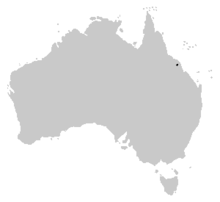Eungella torrent frog
| Eungella torrent frog | |
|---|---|
 | |
| Scientific classification | |
| Kingdom: | Animalia |
| Phylum: | Chordata |
| Class: | Amphibia |
| Order: | Anura |
| Family: | Myobatrachidae |
| Genus: | Taudactylus |
| Species: | T. eungellensis |
| Binomial name | |
| Taudactylus eungellensis Liem & Hosmer, 1973 | |
 | |
| Range of the Eungella torrent frog | |
The Eungella torrent frog (Taudactylus eungellensis) is a species of stream dwelling frog endemic to Australia. It is restricted to ranges west of Mackay in mid-eastern Queensland.
Description
It is a relatively small frog reaching 35mm in length. The head and body are slender and the limbs are long and lean. The dorsum ranges from yellowish-tan to dark brown in colour with darker mottling. There is a X-shaped marking on the back. The front half of the head is usually lighter than the back half and the arms and legs have banding. The toes and feet have wedge-shaped pads and no webbing. The back is smooth or granular with a few low warts. The belly is smooth and deep yellow. The irises restrict horizontally and are golden. The tympanum is indistinct.
Ecology and behaviour
This frog inhabits montane rainforest and tall open forests. It is found in and around flowing creeks. If alarmed the Eungella Torrent Frog may jump into the creek where it will hide beneath rocks until the danger has passed. Breeding may occur all year round but is most intense from November to December. Males make a soft tinkering sound barely audible over the sound of cascading water. Eggs are laid in clumps of 30-50. They are attached to the under surface of submerged rocks or logs. The Eungella torrent frog is the only Myobatrachidae that is known to advertise its presence by the movement of its body and limbs. It is suspected that these movements are a form of courtship. These movements include: flicking and waving of legs, head bobbing, and distinctive hops.
This species is the only known Australian frog to go through an apparent period of absence, only to later reappear. The Eungella torrent frog was first noted to be in decline in the 1980s. From 1987 to 1992 the frog was not encountered, despite surveys. From 1992 onwards it has since been rediscovered at nine sites and populations appear to be slowly on the rise. Although these results are encouraging, populations have not rebounded to what they were before the decline, when they were still considered common. The cause for decline is believed to be the chytrid fungus Batrachochytrium dendrobatidis, however interestingly the frogs now seem to be able to coexist with the fungus that once caused their near extinction.
Conservation status
It is listed as Critically Endangered on the IUCN Red List, and as Endangered under Queensland's Nature Conservation Act 1992.
References
- Retallick et al. (2004). Taudactylus eungellensis. 2006. IUCN Red List of Threatened Species. IUCN 2006. www.iucnredlist.org. Retrieved on 11 May 2006. Database entry includes a range map, a brief justification of why this species is critically endangered, and the criteria used.
- PloS Journal
- Frogs Australia Network - call available here
- Barker, J.; Grigg, G.C.; Tyler,M.J. (1995). A Field Guide to Australian Frogs. Surrey Beatty & Sons.
